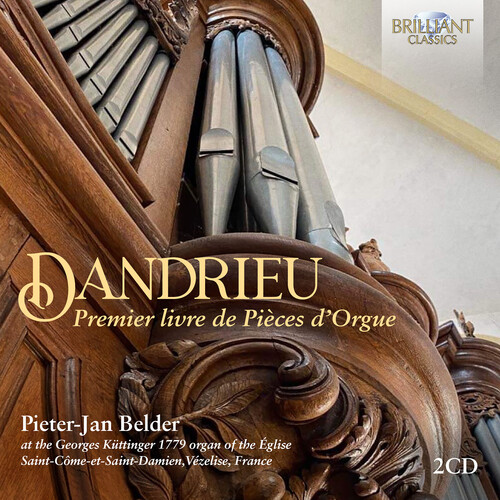Show results for
Deals
- 4K Ultra HD Sale
- Action Sale
- Alternative Rock Sale
- Anime sale
- Award Winners Sale
- Bear Family Sale
- Blu ray Sale
- Blues on Sale
- British Sale
- Classical Music Sale
- Comedy Music Sale
- Comedy Sale
- Country Sale
- Criterion Sale
- Electronic Music sale
- Fantasy Film and TV
- Folk Music Sale
- Hard Rock and Metal Sale
- Horror Sci fi Sale
- Jazz Sale
- Kids and Family Music sale
- Kids and Family Sale
- Metal Sale
- Music Video Sale
- Musicals on Sale
- Mystery Sale
- Naxos Label Sale
- Olive Films on Sale
- Page to Screen Sale
- Paramount Sale
- Pop and Power Pop
- Rap and Hip Hop Sale
- Reggae Sale
- Rock and Pop Sale
- Rock Legends
- Soul Music Sale
- TV Sale
- TV Sale
- Vinyl on Sale
- War Films and Westerns on Sale

Premier Livre de Pieces D Orgue
- Format: CD
- Release Date: 9/22/2023

Premier Livre de Pieces D Orgue
- Format: CD
- Release Date: 9/22/2023
- Composers: Jean-Francois Dandrieu
- Label: Brilliant Classics
- Number of Discs: 2
- UPC: 5028421951379
- Item #: 2633463X
- Genre: Classical Artists
- Release Date: 9/22/2023

Product Notes
Dandrieu's Premier Livre de Pièces d'Orgue was printed a year after the composer died in 1738. It contains six suites of pieces in differing church tones; each followed by six versets suitable for performance under the canticle Magnificat. While the Magnificat verses have a logical sequence; the other movements in the suites are somewhat haphazardly planned. Even setting aside the Pascal hymn in the Premier Suite; the remaining pieces have no apparent order; perhaps reflecting a desire to make the publication as generally useful as possible. The first suite's two fugues are the only cantus firmus pieces in the collection and are based on the hymn Ave Maris Stella and the Pascal proclamation Exultet coelum laudibus (CD 1: 3 and 4). Like the remaining fugues; which are independent; the style is serious: each is marked Majestueusement [sic] and follows the prescriptions of several composers' prefaces from the late 17th and early 18th centuries. While no fugues from this epoch are as carefully crafted as those of the Rouennais organist Jehan Titelouze (Paris; 1623 and 1626); their placing within organised organ masses and hymns; often as the second verset of a Kyrie; Gloria or hymn; demonstrates an underlying association between genre and rhetoric. We see similar associations with the opening movements of each Magnificat set; but they work on two levels. They are austere and reserved solely for a plein jeu combination of stops: foundation stops from 16 feet to both mixtures but without reeds. According to André Raison they are to be played solemnly with absolute finger legato. A second rhetorical association is the link between registration and text. It has been mentioned that fugues were often used as the second verse of hymns and in mass sections; and a similar association between a plein jeu and the first Kyrie; Gloria or Sanctus; or the first verse of a psalm or canticle exists in nearly every organ composer's publication until late into the 18th century. This is not by accident since associating sounds and text would help guide congregants - many of whom were neither literate nor conversant with Latin - through the complexities of the ceremony. Indeed; such an association is well within the ceremonials' inclusive philosophies. Several commentators associate plein jeu pieces with Titelouze; and while the registration provides a link with the north European school of organ playing; particularly of such composers from Flanders and the Spanish Netherlands as Jan Pieterzoon Sweelinck; other genres are decidedly more French. Thus; we have bourrées (e.g.; Duo; Magnificat V; CD2: 15); menuets (e.g.; Basse de Cromorne; Magnificat III; CD1: 33); gavottes (e.g.; Trio; Magnificat V; CD2: 16); gigues (Magnificat IV; CD2: 5); Italianate gigas (Duo; Magnificat III; CD1: 26) and; as mentioned previously; rustic dances in the guise of musettes. It is not only dance forms that permeate French organ music; since we also see the influence of the air de cour in the tender récits (e.g.; Magnificat III; CD1: 33); concerted viol music in the two Tierce en Taille pieces (Suites IV and V) and even Lullyan ouvertures; which form the basis of the offertoires. These are exclusively reserved for grands jeux combinations that juxtapose concertante and ripieno sections using combinations of reeds; cornets and foundation stops that mimic the grand orchestral writing popular with Parisian apparatchiks of the opera.

